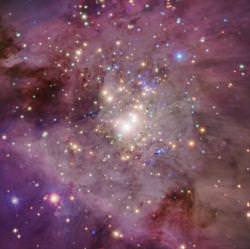Written by Fraser Cain

It's not a huge story, just some cool science and a pretty picture. Here's a newly released image of the Orion Nebula, captured by two of the great observatories: the Chandra X-Ray Observatory and the Hubble Space Telescope. The bright blue and orange points are young stars, blazing out the X-rays visible to Chandra, while the diffuse glow is the surrounding gas and dust revealed by Hubble.
The Orion Nebula is located 1,500 light years away, and it's one of the closest star forming regions to the Earth. Amateur astronomers often direct their telescopes towards this nebula, since it's so close, large and bright.
This image was made by combining photographs captured by both Hubble and Chandra. The Chandra data was built up from almost 13 days of continuous observations, and they allowed astronomers to watch the activity of newborn stars, just 1-10 million years old. During the observation period, the stars flared in their X-ray output. Unlike our own Sun, which is pretty boring as stars go, these young stars are violent and chaotic; demonstrated by the fluctuations of radiation pouring off of them. You wouldn't want to be living on a planet orbiting one of these monsters.
The wispy clouds of gas and dust (seen in pink and purple) are visible light images captured by Hubble. Right now they're wispy filaments, but their gravitational interaction is bringing together new stars. One day these too will ignite in the warm glow of newly formed stars.
Original Source: Chandra News Release



No comments:
Post a Comment